Philippine noodles, deeply ingrained in the country's culinary landscape, offer a diverse and flavorful array of dishes. Pancit, a staple in Filipino cuisine, encompasses a wide range of noodle dishes prepared in various regions. Pancit Canton features stir-fried egg noodles with vegetables and meats, while Pancit Malabon boasts thick rice noodles topped with a rich seafood sauce. Pancit Palabok showcases rice noodles smothered in a vibrant shrimp sauce and garnished with pork cracklings, eggs, and green onions. These noodle dishes celebrate the Philippines' culinary heritage and regional diversity, offering a delicious and satisfying taste of Filipino cuisine.
Cellophane noodles

Cellophane noodles, also known as glass noodles or sotanghon in the Philippines, are a popular ingredient in Filipino cuisine. These translucent noodles are made from mung bean starch and are commonly used in soups, stir-fries, and salads. One classic Filipino dish that showcases the versatility of cellophane noodles is Pancit Sotanghon. Pancit Sotanghon typically consists of stir-fried cellophane noodles mixed with various ingredients such as chicken, shrimp, vegetables, and soy sauce. The dish is bursting with flavors and textures, making it a favorite among Filipinos. The noodles have a slightly chewy texture and absorb the savory flavors of the sauce and other ingredients. The vegetables, such as carrots, cabbage, and bell peppers, add freshness and vibrant colors to the dish. The chicken and shrimp provide a protein-packed element, while the soy sauce adds a salty and umami flavor. Pancit Sotanghon is often garnished with sliced green onions, fried garlic, and a squeeze of calamansi, a Philippine citrus fruit, for a tangy kick. Whether enjoyed as a main dish or a side, Pancit Sotanghon is a delicious and satisfying Filipino noodle dish that showcases the unique taste and texture of cellophane noodles.
Pancit

Pancit is a traditional Filipino noodle dish that is often served during special occasions and gatherings. This flavorful and versatile dish is a staple in Filipino cuisine and comes in various regional variations. The most common type of pancit is called Pancit Canton, which features stir-fried egg noodles cooked with a medley of vegetables and a choice of meat such as chicken, pork, or shrimp. The noodles are typically seasoned with soy sauce, garlic, and other spices, giving it a savory and umami flavor. Another popular variation is Pancit Bihon, which uses rice vermicelli noodles instead of egg noodles. It is cooked similarly to Pancit Canton, with a combination of vegetables and meat, creating a light and delicate dish. Pancit Malabon is a regional specialty that originated from Malabon City. It features thick rice noodles topped with a rich sauce made from shrimp, ground pork, and annatto oil. It is then garnished with various toppings like hard-boiled eggs, chicharon (crispy pork rinds), and green onions. Pancit is not only delicious but also symbolizes long life and good luck in Filipino culture, making it a must-have dish for celebrations and gatherings.
Filipino Spaghetti
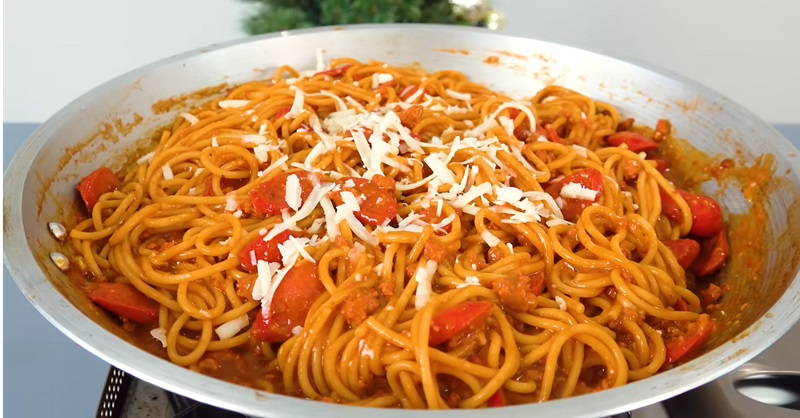
Filipino spaghetti, known as sweet spaghetti, is a delightful fusion of Italian and Filipino flavors. Featuring a uniquely sweet sauce crafted from tomato sauce, brown sugar, and banana ketchup, it distinguishes itself from traditional Italian Bolognese. Toppings include sliced hot dogs or smoked longganisa sausages, giniling (ground meat), and grated cheese. A beloved comfort food in the Philippines, it graces special occasions, especially children's birthdays. Originating between the 1940s and 1960s during the American Commonwealth Period, the dish evolved due to tomato shortages in World War II, leading to the local innovation of banana ketchup and the adaptation of spaghetti to suit Filipino preferences for sweetness.
Batchoy
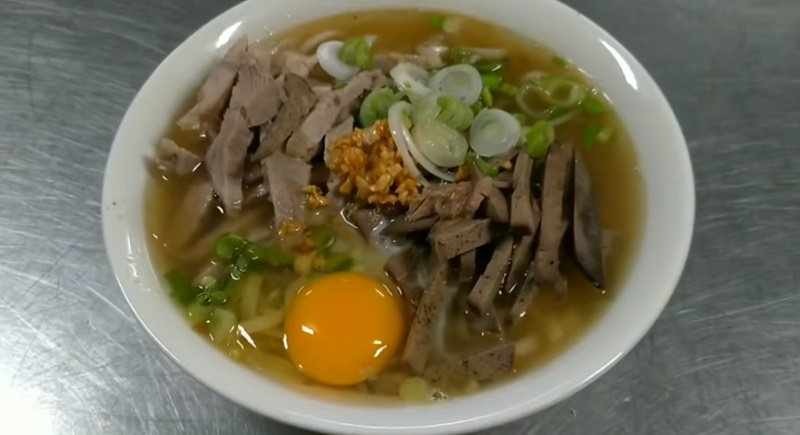
Batchoy is a delicious and hearty noodle dish that originated from the Philippines. It is a popular comfort food that is commonly enjoyed during cold weather or rainy days. The dish consists of a rich and flavorful broth made from pork or beef bones, simmered for hours to extract all the delicious flavors. The broth is then infused with soy sauce and other seasonings, giving it a savory and umami taste. The noodles used in Batchoy are typically egg noodles, which are cooked until tender and then added to the broth. The dish is then garnished with a variety of ingredients such as sliced pork or beef, liver, chicharron (crispy pork cracklings), and vegetables like cabbage and spring onions. What sets Batchoy apart is the addition of a special ingredient called "guinamos" or shrimp paste. This adds a unique and distinct flavor to the dish, making it truly one-of-a-kind. Batchoy is a complete meal on its own, providing a combination of textures and flavors that are sure to satisfy any palate.
Lomi
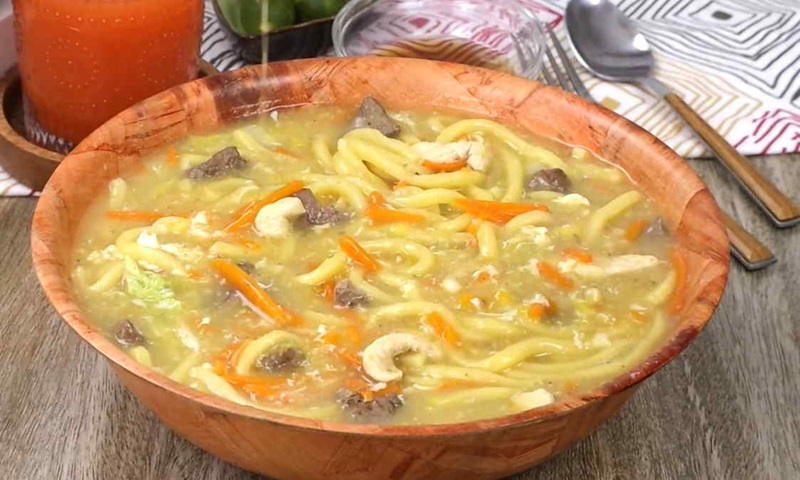
Lomi is a popular noodle dish in the Philippines that originated from the province of Batangas. It is a hearty and comforting meal that is often enjoyed during rainy days or cold weather. Lomi is made with thick egg noodles that are cooked in a flavorful broth made from pork or chicken bones, soy sauce, and various spices. The dish is typically filled with an array of ingredients such as sliced pork, chicken, liver, shrimp, and vegetables like cabbage, carrots, and mushrooms. It is then topped with hard-boiled eggs and garnished with spring onions for added freshness and aroma. What sets Lomi apart from other noodle dishes is its thick and starchy consistency, which comes from the addition of cornstarch or tapioca starch. This creates a velvety and satisfying texture that coats each strand of noodle. Lomi is often enjoyed as a main course and is best served hot. Its rich and savory flavors make it a favorite among Filipinos, and it is commonly found in local eateries or street food stalls.
Mami Soup
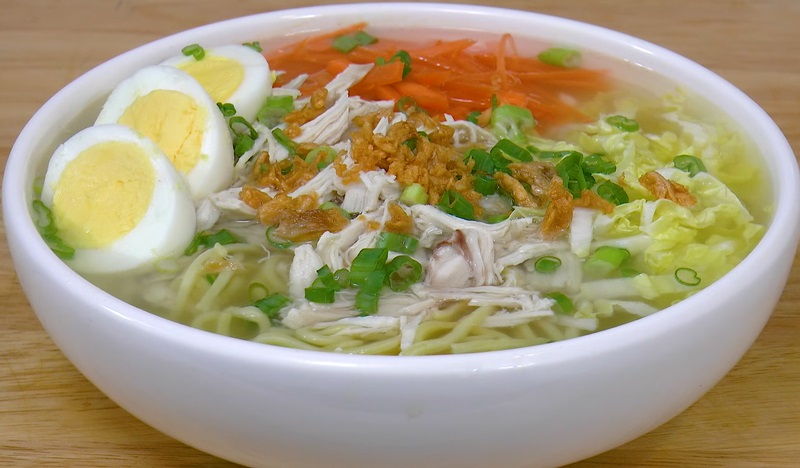
Philippine Mami soup is a delicious and hearty noodle dish that is loved by locals and visitors alike. It is a popular street food and comfort food in the Philippines. Mami soup is typically made with wheat flour (egg) noodles, which are cooked until they are soft and chewy. The soup base is usually made from a flavorful combination of chicken or beef broth, infused with spices and seasonings. The broth is simmered for hours to enhance its rich flavor. The noodles are then added to the broth, along with various ingredients such as tender slices of meat (usually chicken or beef), crunchy vegetables like bok choy or cabbage, and garnished with chopped green onions and fried garlic. Mami soup is often served with a side of soy sauce or chili sauce for added flavor and heat. It is best enjoyed piping hot, especially on a rainy day or when feeling under the weather, as it is believed to have comforting and healing properties. This noodle soup dish is not only delicious but also a complete meal in itself, providing a balance of carbohydrates, protein, and vegetables.
Sopas
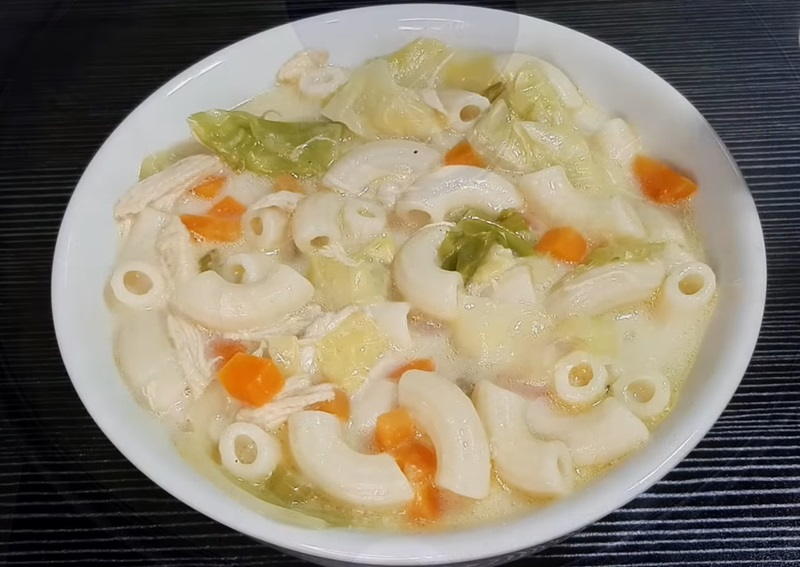
Sopas, a popular Filipino dish, is a hearty noodle soup that is beloved for its comforting flavors and creamy texture. This dish typically consists of macaroni noodles cooked with chicken, vegetables, and milk or cream. The base of the soup is made by sautéing garlic and onions in oil until fragrant. Chicken pieces are then added and cooked until browned. Carrots, celery, and cabbage are commonly included in the soup, providing a fresh and crunchy element. The mixture is then simmered with chicken broth until the flavors meld together. Once the vegetables are tender, macaroni noodles are added to the pot and cooked until al dente. The dish is finished off by pouring in milk or cream, which adds a rich and velvety texture to the soup. The milk or cream is typically heated gently to avoid curdling. Sopas is often served hot and garnished with shredded chicken, fried garlic, and chopped spring onions.
Pancit Malabon

Pancit Malabon is a popular Filipino noodle dish that originated from Malabon City, Philippines. It is a flavorful and hearty dish that is often served during special occasions and celebrations. The dish is made with thick rice noodles, known as "pancit Malabon noodles," which are stir-fried with various ingredients and topped with a rich and savory sauce. The toppings can include boiled shrimp, squid, smoked fish flakes, crushed chicharon (pork cracklings), and hard-boiled eggs. The sauce of Pancit Malabon is made from a combination of shrimp broth, achuete (annatto seeds) oil, and various seasonings, giving it a distinct and delicious flavor. The noodles are then tossed in the sauce and cooked until they absorb all the flavors. Pancit Malabon is known for its vibrant colors and bold flavors. It is often garnished with fresh calamansi (Philippine lime) and chopped green onions for added freshness and tanginess.
Odong
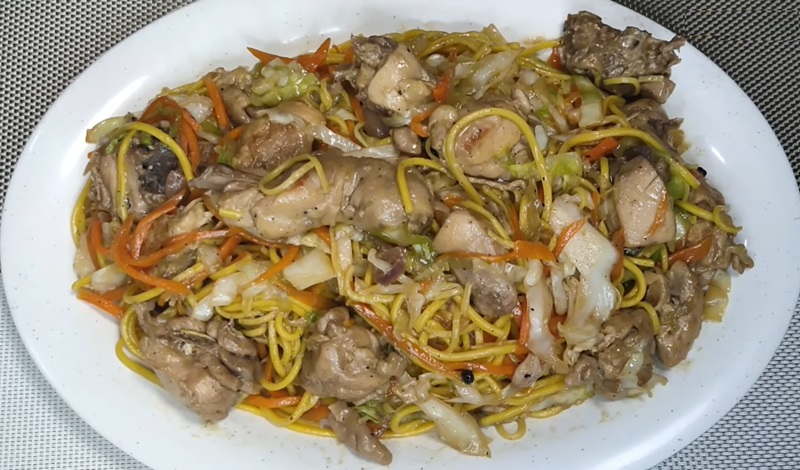
Odong is a popular Filipino noodle dish that is often enjoyed as a comforting meal. It is a fusion of Chinese and Filipino flavors, creating a unique and delicious culinary experience. The dish is typically made with thick egg noodles, stir-fried with an assortment of vegetables, meat, and seafood. Odong usually includes ingredients such as shrimp, squid, pork, chicken, and various vegetables like cabbage, carrots, and bell peppers. The noodles are cooked until tender and then tossed with a flavorful sauce made from soy sauce, oyster sauce, and other seasonings. The combination of the tender noodles, succulent meats, and crunchy vegetables creates a delightful mix of textures and flavors. The dish is typically garnished with spring onions and served with a side of calamansi or lime wedges for added tanginess.
Kinalas
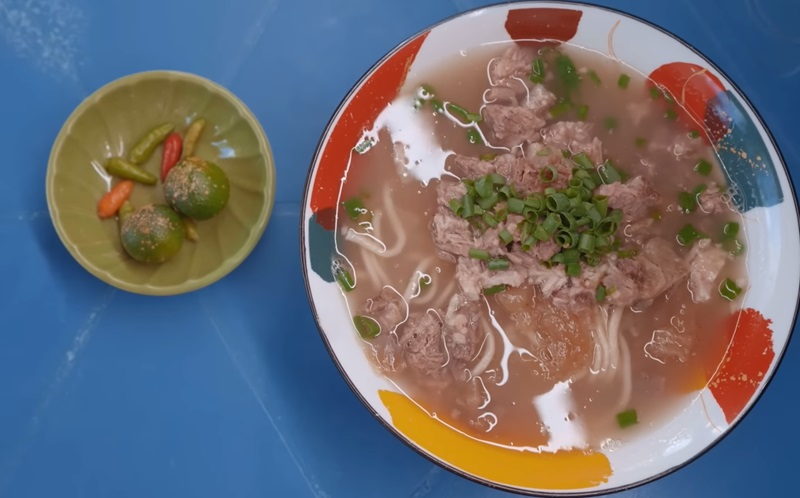
Kinalas is a popular Filipino dish that hails from the province of Naga in the Philippines. It is a hearty noodle dish that is known for its rich and flavorful broth, tender meat, and chewy noodles, garnished by scraped meat from pork or beef's head and other parts. The dish is typically made with thick rice noodles, which are simmered in a flavorful broth made from boiled beef or pork bones, and then topped with tender pieces of meat, often from the same bones used to make the broth. What sets Kinalas apart from other noodle dishes is its unique method of preparation. The noodles are traditionally boiled separately from the broth, and then placed in a bowl where the hot broth is poured over them. This ensures that the noodles retain their chewy texture and do not become overcooked. To enhance the flavors of the dish, Kinalas is often served with a variety of condiments such as soy sauce, vinegar, chili oil, and calamansi (a local citrus fruit). These condiments can be added to taste, allowing each individual to personalize their bowl of Kinalas according to their preferences.
Pancit Molo
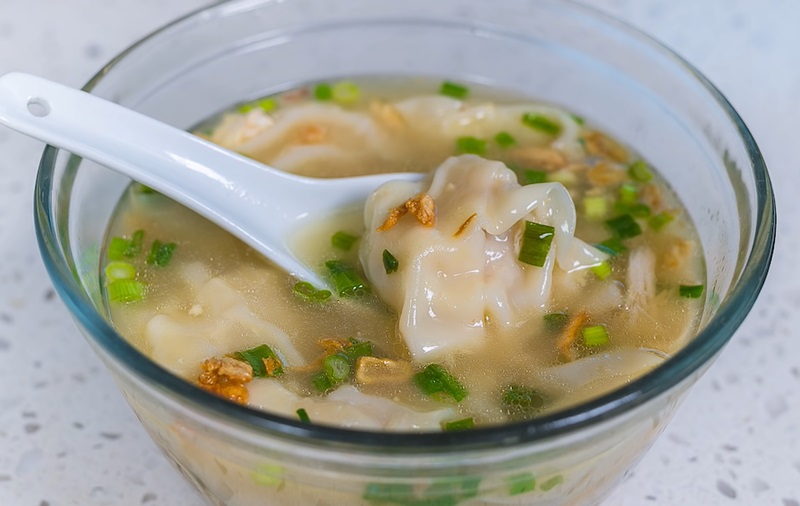
Pancit Molo is a popular noodle dish in the Philippines, specifically in the region of Iloilo. It is known for its rich and savory flavors, making it a favorite among locals and tourists alike. The dish is made with a delicate and flavorful broth, typically made from chicken or pork bones, which is simmered for hours to extract all the goodness. The broth is then infused with aromatics like garlic, onions, and ginger, giving it a comforting and aromatic appeal. The star of Pancit Molo is the dumplings, which are small and filled with a mixture of ground pork, shrimp, and various seasonings. These dumplings are then cooked in the flavorful broth until they are tender and bursting with flavor. To complete the dish, the dumplings and broth are served together with thin egg noodles, green onions, and fried garlic. The combination of the tender dumplings, tasty broth, and the slight crunch of the garlic creates a textural and flavorful harmony that is truly satisfying. Pancit Molo is often enjoyed as a main course or even as a starter during special occasions and family gatherings. Its comforting flavors and heartwarming appeal make it a beloved Filipino dish that is sure to leave you wanting more.
Shing-a-ling (food)
-1704898252.jpg)
Shing-a-ling is a beloved Filipino snack that has gained popularity for its crispy and addictive nature. This crunchy treat is made from deep-fried noodles, typically using miki or pancit canton noodles. The noodles are cut into small pieces or strips before they are fried to perfection, resulting in a delightful texture that is both crispy and chewy. Shing-a-ling is often flavored with a combination of savory and spicy seasonings, such as garlic powder, onion powder, chili powder, and salt. The seasoning adds a delicious kick to the noodles, making it a flavorful and irresistible snack option. This Filipino dish is commonly enjoyed on its own as a snack, but it can also be used as a topping or garnish for other dishes. Some people even enjoy it as a crunchy addition to salads or soups, adding a unique and satisfying element. Shing-a-ling is widely available in the Philippines, particularly in local markets, street food stalls, and convenience stores. It has become a staple snack that is loved by people of all ages, offering a delightful burst of flavor and texture in every bite.
Maki mi
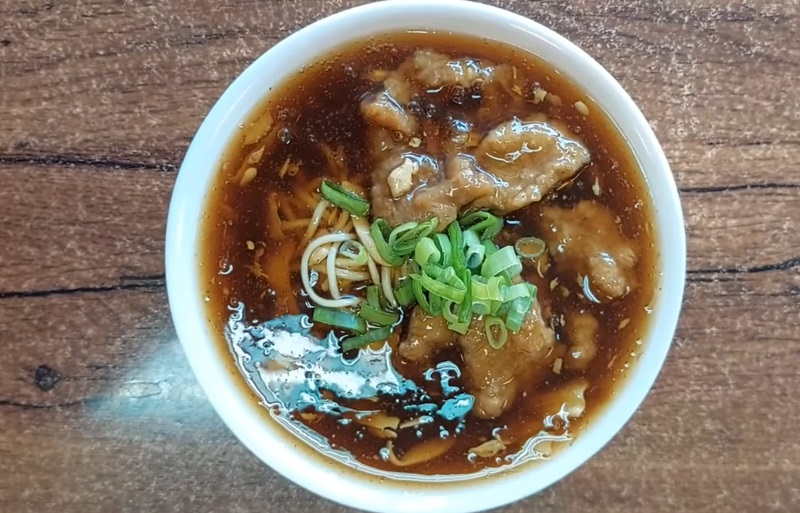
Maki mi is a delicious Filipino noodle dish that is packed with flavors and textures. It is a combination of two popular noodle dishes in the Philippines, pancit miki and pancit canton. Maki mi typically consists of thick egg noodles, stir-fried with a medley of vegetables such as cabbage, carrots, and bell peppers. It is then seasoned with a savory sauce made from soy sauce, oyster sauce, and garlic. What sets maki mi apart from other noodle dishes is the addition of meat and toppings. It is commonly served with sliced pork, chicken, and shrimp, giving it a hearty and satisfying taste. Other toppings such as boiled eggs and chicharon (pork cracklings) are also added to enhance the overall flavor and texture. Maki mi is a popular comfort food in the Philippines, enjoyed by people of all ages. It is commonly served during special occasions and gatherings, as well as being a staple street food. The combination of the chewy noodles, savory sauce, and flavorful toppings make maki mi a truly delightful dish that showcases the rich culinary heritage of the Philippines.
Batchoy Tagalog
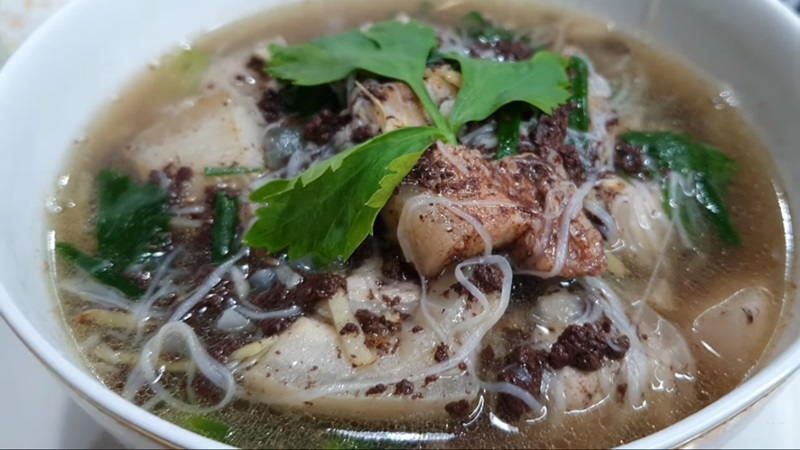
Batchoy Tagalog is a popular noodle dish from the Philippines that originated in the province of Iloilo. It is a hearty and flavorful soup that combines Chinese and Filipino influences. The dish features thick egg noodles, generous amounts of tender pork meat, liver, and intestines, topped with crunchy chicharon (pork cracklings). The broth is made from a combination of pork and beef bones, simmered for hours to extract its rich flavor. It is then seasoned with soy sauce and fish sauce, giving it a savory and umami taste. Batchoy Tagalog is also known for its distinct flavorings, such as garlic, onions, and annatto oil, which gives the soup its vibrant red color. This noodle dish is commonly served with a side of crushed chili peppers, calamansi (Filipino lime), and patis (fish sauce) for added tanginess and spiciness. The combination of textures and flavors in Batchoy Tagalog creates a truly satisfying and comforting meal, perfect for any occasion.
Pancit choca
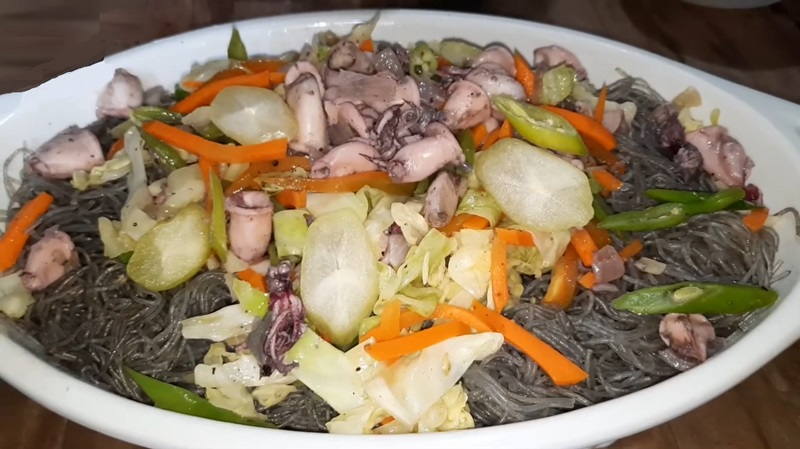
Pancit choca is a traditional Filipino noodle dish that hails from the province of Cebu in the Philippines. It is a unique and flavorful noodle dish that combines Chinese and Filipino influences. The dish is typically made with sautéed noodles, vegetables, and a variety of meats such as chicken, pork, and shrimp. The noodles used in pancit choca are specially made from ground rice and are thicker than traditional pancit noodles. They have a chewy texture which adds to the overall appeal of the dish. The dish is usually stir-fried with garlic, onions, and soy sauce, giving it a savory and slightly sweet flavor. What sets pancit choca apart is the addition of chicharon, a crispy pork crackling, which is sprinkled on top of the dish before serving. This adds a delightful crunch and richness to the noodles. It is also often garnished with green onions and calamansi, a local citrus fruit, which adds a refreshing tang to the dish. Pancit choca is a beloved dish in Cebu and is often served during special occasions and celebrations. Its unique combination of flavors and textures make it a delightful and satisfying meal that is enjoyed by locals and visitors alike.
Pancit buko
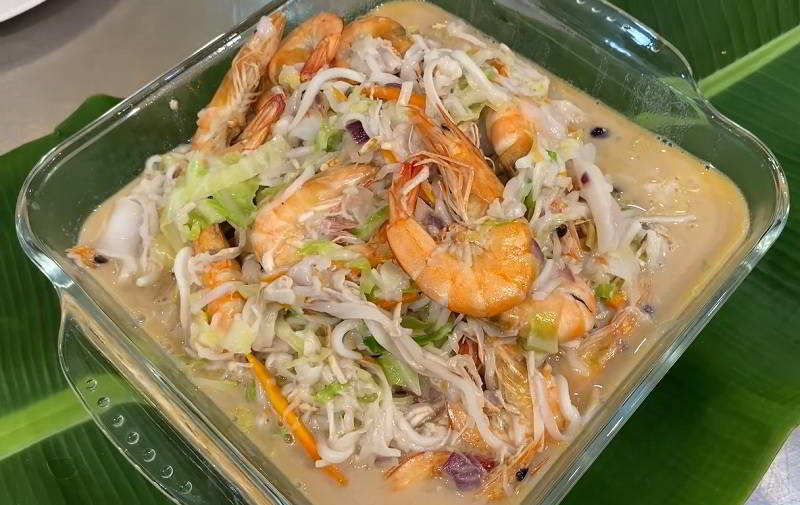
Pancit buko is a delicious and unique Filipino dish that features noodles made from young coconut meat, giving it a distinct and refreshing taste. This dish is a fusion of flavors, combining the traditional pancit noodles with the natural sweetness and crunchiness of buko. The dish starts by sautéing garlic, onions, and a medley of vegetables such as carrots, bell peppers, and cabbage. The noodles made from buko are then added, along with soy sauce and other seasonings, creating a savory and umami-rich base. To enhance the flavors, some variations also include shrimp, chicken, or pork. Pancit buko is typically garnished with sliced green onions, calamansi or lime wedges, and crispy fried garlic for added texture and aroma. The combination of the tender noodles and the crunchy vegetables results in a satisfying and wholesome dish that is a favorite among Filipinos. This unique twist on the classic pancit noodles showcases the versatility and creativity of Filipino cuisine. Whether enjoyed as a main course or as a side dish, Pancit buko is a delightful and refreshing addition to any Filipino feast.
Pancit palabok
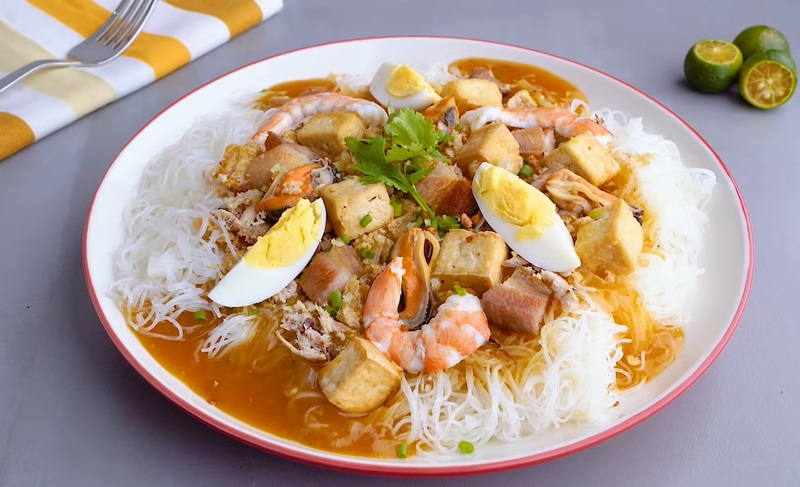
Pancit palabok is a popular Filipino noodle dish that is known for its vibrant flavors and colorful presentation. This dish is typically made with thin rice noodles, which are cooked until tender and then topped with a rich and savory sauce. The sauce is made from a combination of shrimp broth, annatto seeds, garlic, and fish sauce, giving it a distinct and delicious taste. Once the noodles are coated in the sauce, they are then garnished with an array of toppings. Common toppings include cooked shrimp, crushed chicharron (pork cracklings), hard-boiled eggs, green onions, and fried garlic. These toppings not only add texture and visual appeal to the dish but also enhance the overall flavor. Pancit palabok is often served during special occasions and gatherings, as it is considered a festive and indulgent dish. It is enjoyed by many Filipinos for its unique blend of flavors and the satisfying combination of soft noodles and crunchy toppings. Whether served as a main course or as a side dish, pancit palabok is a delightful and flavorful addition to any Filipino meal.
Pancit bihon

Pancit bihon is a popular Filipino dish that features thin rice noodles stir-fried with a variety of ingredients. It is a staple in Filipino cuisine and is often served during special occasions or family gatherings. To prepare pancit bihon, the rice noodles are first soaked in water until they soften. Then, they are stir-fried with a medley of vegetables such as carrots, cabbage, and green beans. Some variations of pancit bihon also include meat, such as chicken, pork, or shrimp, for added flavor and protein. The dish is typically seasoned with soy sauce and other condiments like oyster sauce or fish sauce, which give it a savory and slightly sweet taste. It is often garnished with green onions and a squeeze of calamansi or lemon juice to add a refreshing tang. Pancit bihon is a versatile dish that can be served as a main course or as a side dish to complement other Filipino dishes. Its vibrant colors, rich flavors, and satisfying texture make it a favorite among Filipinos and foreigners alike.
Pancit estacion
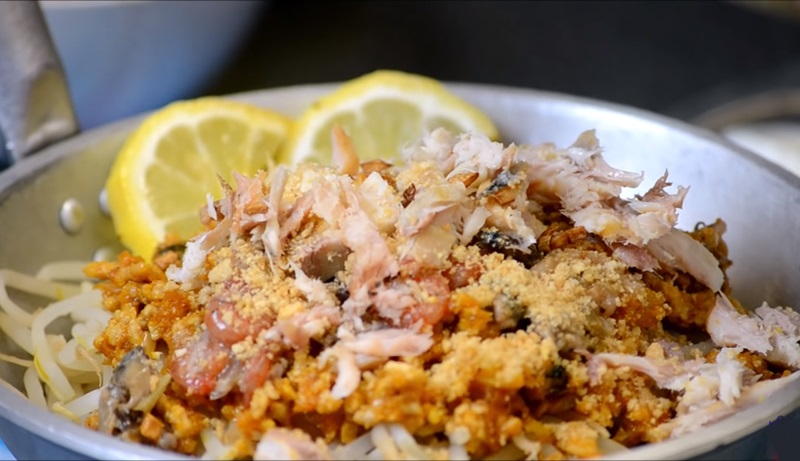
Pancit Estacion is a popular noodle dish in the Philippines that originated from Malabon, a city in Metro Manila known for its rich culinary heritage. This dish is a delicious medley of flavors and textures, making it a favorite among locals and tourists alike. The star of Pancit Estacion is the thick rice noodles, which are stir-fried with an array of ingredients such as shrimp, pork, and various vegetables like cabbage, carrots, and green beans. The noodles are cooked until tender, absorbing the flavors of the savory sauce made from soy sauce and other seasonings. What sets Pancit Estacion apart is the addition of crispy pork cracklings, locally known as chicharon, which adds a delightful crunch to the dish. It is also topped with sliced boiled eggs and garnished with fresh calamansi, a local citrus fruit, which adds a tangy and refreshing twist. Pancit Estacion is often served during special occasions and gatherings, symbolizing long life and good luck. Its vibrant colors and enticing aroma make it an eye-catching dish that is as pleasing to the palate as it is to the eyes. Whether enjoyed as a main course or a side dish, Pancit Estacion is a true Filipino culinary delight.
Sotanghon
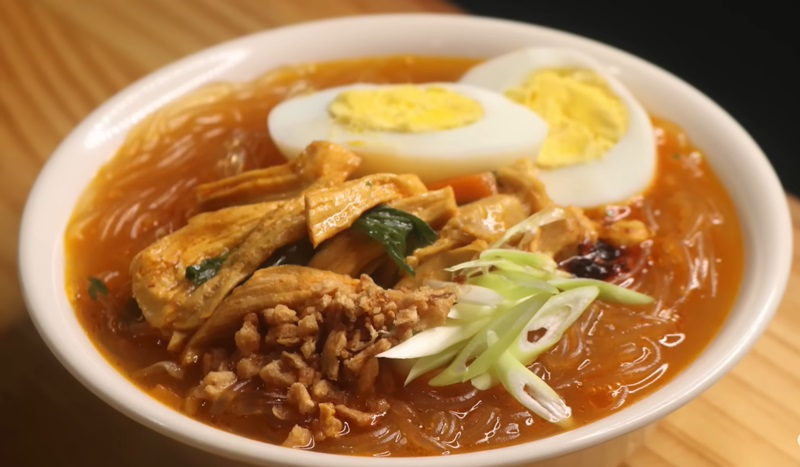
Sotanghon is a popular noodle dish in the Philippines that is typically made with glass noodles, also known as cellophane noodles or sotanghon noodles. These noodles are made from mung bean starch and are translucent and delicate in texture. The dish itself is a flavorful combination of stir-fried noodles, vegetables, and meat or seafood. To prepare Sotanghon, the noodles are first soaked in water to soften them. Then, they are stir-fried with garlic, onions, and various vegetables such as carrots, bell peppers, and cabbage. Protein options include chicken, pork, shrimp, or a combination of these. The dish is often seasoned with soy sauce, oyster sauce, and other condiments to enhance its taste. Sotanghon is a versatile dish that can be served as a main course or a side dish. It is commonly enjoyed during family gatherings, celebrations, or as a comforting meal during colder months. The noodles have a unique chewy texture and absorb the flavors of the ingredients, making each bite flavorful and satisfying. Overall, Sotanghon is a delicious and popular Filipino noodle dish that showcases the rich flavors and textures of Philippine cuisine.
Pancit canton

Pancit Canton is a popular Filipino dish that showcases the vibrant and diverse culinary culture of the Philippines. This noodle dish is made with thick egg noodles, stir-fried with an array of colorful vegetables, meat or seafood, and a savory sauce. The dish typically starts with sautéing garlic and onions in oil, creating a fragrant base for the other ingredients. The noodles are then added and stir-fried until they are cooked and coated in the flavors of the sauce. Common additions to Pancit Canton include sliced chicken, pork, shrimp, or a combination of these proteins. To enhance the dish's flavors and add a vibrant touch, various vegetables are incorporated, such as carrots, bell peppers, cabbage, and snow peas. These vegetables not only provide a delightful crunch but also contribute to the dish's visual appeal. Pancit Canton is often served as a special dish during birthdays and other celebrations in the Philippines. Its delicious combination of flavors, textures, and vibrant colors make it a favorite among locals and visitors alike. Whether enjoyed as a main course or a side dish, Pancit Canton is a delightful representation of Philippine cuisine.
Pancit miki
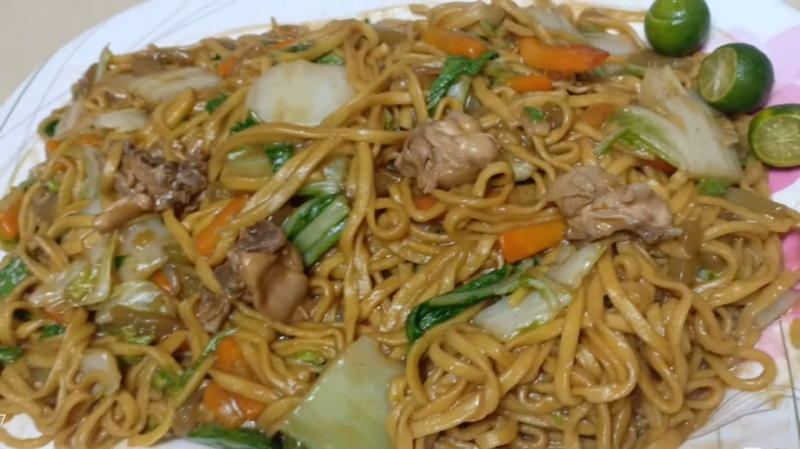
Pancit Miki is a traditional Filipino noodle dish that is popularly served during special occasions and gatherings. It features thick egg noodles called "miki" that are stir-fried with an array of vegetables, meat, and flavorful seasonings. The dish typically starts with sautéing garlic and onions in oil, followed by the addition of sliced meat like pork, chicken, or shrimp. Vegetables such as carrots, cabbage, bell peppers, and snow peas are then added to the mix, providing a vibrant burst of colors and textures. The miki noodles are then incorporated, soaking up the flavors from the ingredients. To enhance the taste, a combination of soy sauce, oyster sauce, and sometimes fish sauce is added, giving the dish a savory and slightly sweet profile. Some variations of Pancit Miki may also include additional toppings like hard-boiled eggs and chicharon (crispy pork rinds) for added crunch and richness. Pancit Miki is a hearty and satisfying dish that showcases the balance of flavors and textures that Filipino cuisine is known for. It is a beloved dish that brings people together and is often enjoyed with loved ones, making it a staple in Filipino celebrations.
Pancit luglug
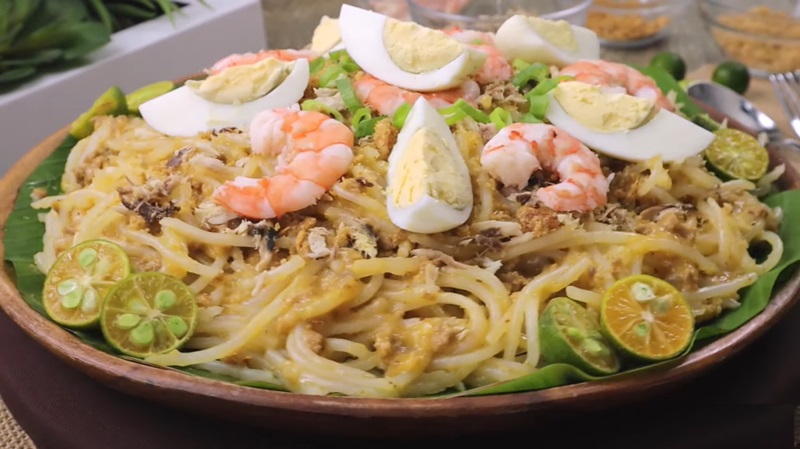
Pancit luglug is a popular Filipino noodle dish that originated in the province of Pampanga, known for its rich culinary heritage. It is a delicious and hearty dish made with rice noodles, typically thicker than the ones used in other noodle dishes, and topped with a flavorful sauce. The dish is prepared by boiling the noodles until they are cooked al dente, then draining them and setting them aside. The sauce is made by sautéing garlic, onions, and shrimp in oil, before adding a mixture of shrimp broth, annatto (achuete) powder, and fish sauce. This mixture is simmered until it thickens and develops a deep, savory flavor. The cooked noodles are then arranged on a plate and generously topped with the sauce, along with other toppings such as hard-boiled eggs, shrimp, ground pork, chicharon (crispy pork rinds), and green onions. The dish is usually served with calamansi (Philippine lime) on the side, which adds a tangy kick to the overall flavor. Pancit luglug is a beloved Filipino comfort food that is often served during special occasions and gatherings. Its combination of flavors and textures makes it a truly satisfying and enjoyable noodle dish.
Udong (food)
-1704933456.jpg)
Udong, also known as pancit bihon, is a popular noodle dish in the Philippines. Made with thin rice noodles, this dish is a flavorful medley of stir-fried vegetables, meat, and seafood. The dish typically starts with sautéing garlic and onions in a hot wok, followed by adding slices of meat such as pork or chicken. Once the meat is cooked, an assortment of vegetables like carrots, cabbage, and bell peppers are added, providing a vibrant and crunchy texture. Seafood options like shrimp and squid are also commonly included. The star of the dish, the rice noodles, are then added and stir-fried with soy sauce and other seasonings, infusing them with a savory flavor. The noodles absorb the flavors of the ingredients, resulting in a mouthwatering combination of tastes. Udong is often served with a squeeze of calamansi, a citrus fruit native to the Philippines, which adds a tangy kick to the dish. It is a versatile and filling meal that can be enjoyed as a main course or as a side dish in Filipino gatherings and celebrations.
Seaweed pancit

Seaweed Pancit is a popular noodle dish in the Philippines that showcases the unique flavors and textures of local cuisine. This dish combines the freshness of seaweed with the savory goodness of stir-fried noodles, creating a harmonious blend of flavors. The star ingredient, seaweed, adds a distinct taste of the ocean and a delightful chewy texture to the dish. It is usually sourced from the coastal areas of the Philippines, where it is abundantly available. The noodles used in this dish are typically thin rice noodles, which absorb the flavors of the other ingredients beautifully. To make Seaweed Pancit, the noodles are stir-fried with a medley of vegetables such as carrots, cabbage, and bell peppers. The dish is then seasoned with soy sauce, garlic, and other spices to enhance its taste. Some variations may include the addition of shrimp, chicken, or pork to make it heartier. Seaweed Pancit is a popular choice for both lunch and dinner, enjoyed by Filipinos of all ages. Its unique combination of flavors, textures, and nutritional benefits make it a healthy and satisfying meal option. Whether enjoyed as a main course or a side dish, this delightful noodle dish is a delicious representation of Philippine cuisine.
Miswa
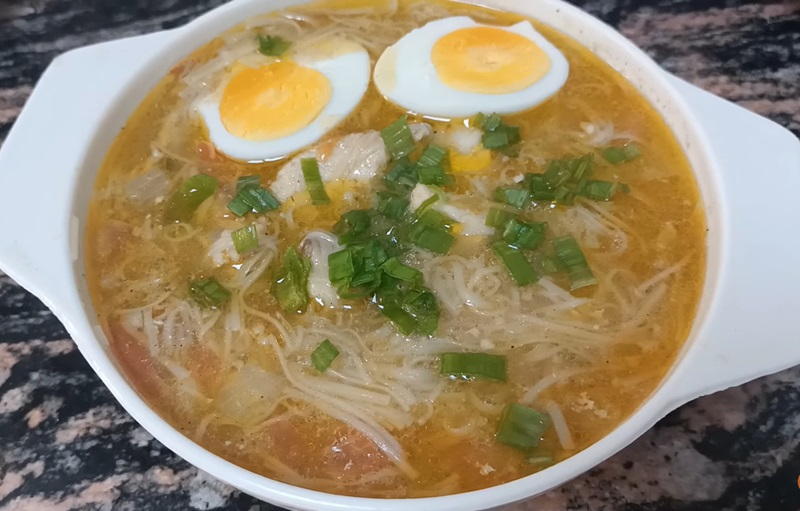
Miswa is a popular noodle dish in the Philippines that is known for its thin, wiry noodles. Made from wheat flour, miswa noodles are delicate and have a slightly chewy texture. This dish is typically served in a clear broth, which is often flavored with meat or seafood. The broth is prepared by simmering meat bones or seafood shells for hours, resulting in a flavorful and aromatic base. It is then strained to remove any impurities. The miswa noodles are cooked separately and added to the broth just before serving, ensuring that they retain their firmness. Miswa is often garnished with a variety of ingredients such as thinly sliced pork, shrimp, or chicken. Vegetables like carrots, cabbage, and green onions are also commonly added to enhance the dish's freshness and color. Some variations of miswa include the addition of fried garlic or a splash of calamansi juice for extra flavor. This hearty and comforting noodle dish is enjoyed by Filipinos all year round but is particularly popular during special occasions and family gatherings. Its simplicity and versatility make miswa a beloved staple in Philippine cuisine.







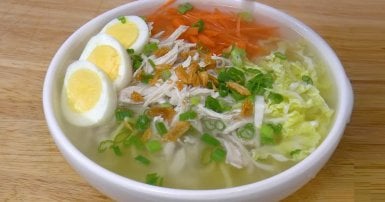

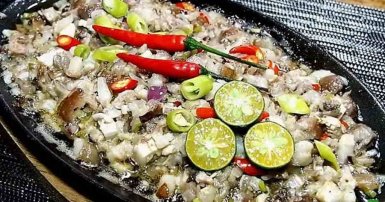



-1709813013.jpg)


